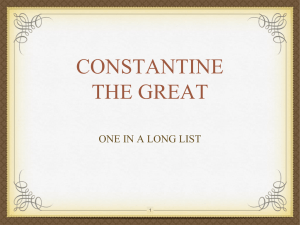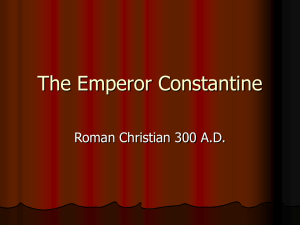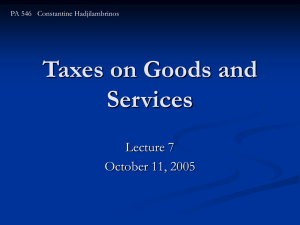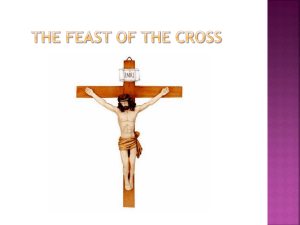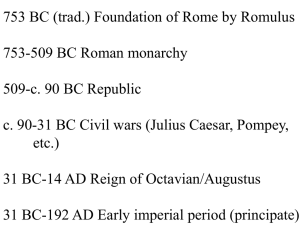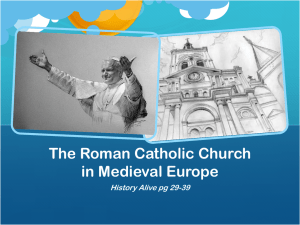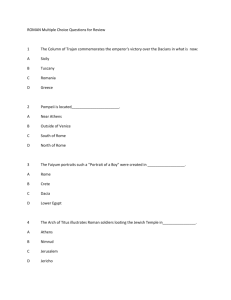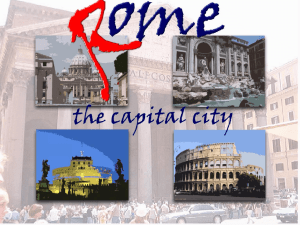Constantine and Christianity
advertisement
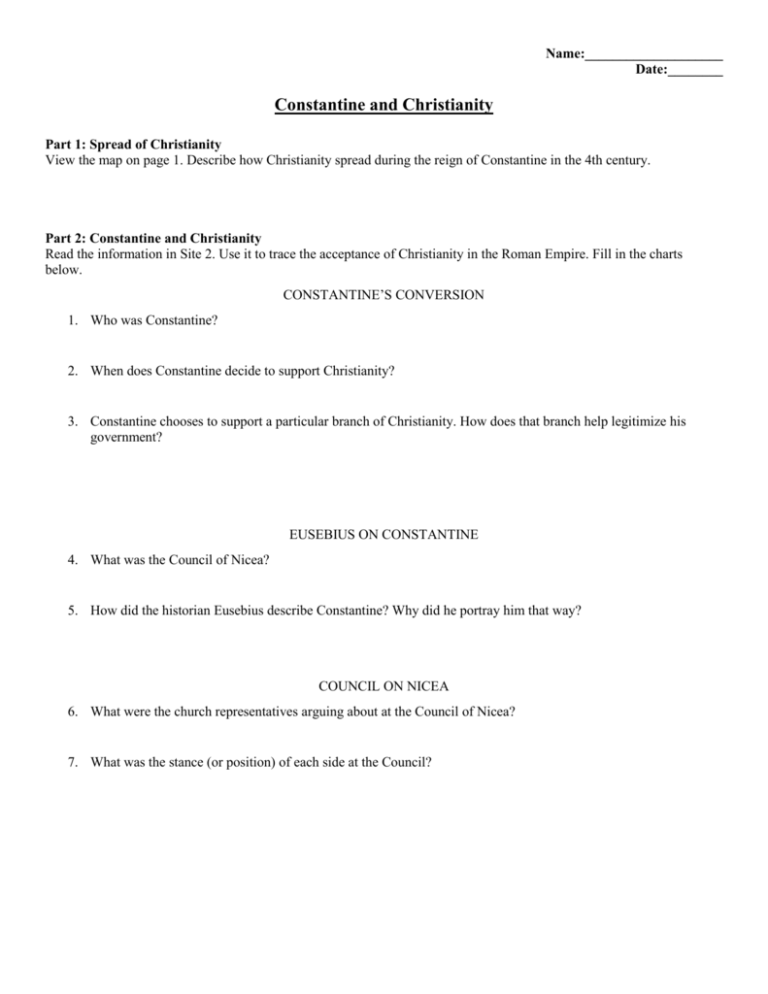
Name:____________________ Date:________ Constantine and Christianity Part 1: Spread of Christianity View the map on page 1. Describe how Christianity spread during the reign of Constantine in the 4th century. Part 2: Constantine and Christianity Read the information in Site 2. Use it to trace the acceptance of Christianity in the Roman Empire. Fill in the charts below. CONSTANTINE’S CONVERSION 1. Who was Constantine? 2. When does Constantine decide to support Christianity? 3. Constantine chooses to support a particular branch of Christianity. How does that branch help legitimize his government? EUSEBIUS ON CONSTANTINE 4. What was the Council of Nicea? 5. How did the historian Eusebius describe Constantine? Why did he portray him that way? COUNCIL ON NICEA 6. What were the church representatives arguing about at the Council of Nicea? 7. What was the stance (or position) of each side at the Council? IMPLICATIONS OF CONSTANTINE’S CONVERSION Five Political Outcomes of Constantine's Conversion CONSTANTINE’S CONVERSION Examples of Constantine's Continued Tolerance for Paganism Why are political instability, and frequent, violent changes in leadership a serious problem for government? Can adopting a state religion that everyone has to follow solve some of those problems? How? What are the negative consequences of having a state-mandated religion? Part 3: Saint Constantine Carefully examine the three paintings: "The Baptism of Constantine," "The Cross Appears to Constantine," and "The Battle at Milvian Bridge." Use the paintings to answer the following questions: 1. "The Baptism of Constantine" is historically inaccurate. In reality, Constantine was on his deathbed when he was baptized. Why do you think that the artist chose to depict Constantine's conversion to Christianity as having taken place in the prime of his life? 2. How does the representation of Constantine in all of these paintings help you to answer the Focus Question: How did Emperor Constantine become Saint Constantine? Give specific examples from the paintings. map #1 image #1 image #2 image #3 Legitimization Under Constantine From persecuted minority to official imperial religion - what caused this extraordinary reversal for Christianity? CONSTANTINE'S CONVERSION One of the most surprising Christian heroes in the entire tradition, I think, is Constantine. He is, first of all, a successful general. He is also the son of a successful general and at the head of the army at the West. And he's fighting another successful general, struggling for who is going to be at the top of the heap of the very higher echelons of Roman government. What happens is that Constantine has a vision. Luckily for the Church, there's a bishop nearby to interpret what the vision means. Constantine ends not converting, technically, to Christianity, but becoming a patron of one particular branch of the church. It happens to be the branch of the church that has the Old Testament as well as the New Testament as part of its canon. Which means that since this branch of Christianity includes the story about historical Israel as part of its own redemptive history, it has an entire language for articulating the relationship of government and piety. It has the model of King David. It has the model of the kings of Israel. And it's with this governmental model that the bishop explains the vision to Constantine. In a sense Constantine becomes the embodiment of the righteous king. And once he consolidates his power by conquering, eventually, not only the West, but also the Greek East where there are many more Christians [who are] concentrated in the cities, which are the social power packets of this culture, [he] is in this amazing position of having a theology of government that he can use to consolidate his own secular power. And it works both ways. The bishops now have basically federal funding to have sponsored committee meetings so they can try to iron out creeds and get everybody to sign up. EUSEBIUS ON CONSTANTINE Who is Eusebius? Eusebius was the bishop of Caesarea in Palestine in the 4th century, and he played a very active role in church politics at the time. He was at the Council of Nicea, which was the first major Christian council. And he had contact with the Emperor Constantine. So he was a very prominent figure. He's most important to us, however, as the first church historian. He wrote several things during his long and active lifetime including a history of the martyrs of Palestine, a collection of prophetic texts. But the most important work is his ecclesiastical history, which describes the development of the church down through his own period, and then the persecutions which took place in the first decade of the fourth century. And finally the vindication of the church with the accession of Constantine and his rise to supreme power. ... Eusebius is, first of all, valuable as an historian because he preserves a large number of sources that are not available in other forms. And how does Eusebius portray Constantine? Constantine would have been conceived by Eusebius and portrayed by Eusebius in magnificent terms. And you have to understand that Constantine, when Eusebius portrays him, is someone who had just achieved total domination over the whole of the Roman Empire. And he was a figure of commanding stature, of commanding power and authority, a figure who by the year 324 had no rivals within the Roman world. And so clothed in imperial garments and radiating the splendor of the sun, he appears in the portraits of Eusebius in some ways as a quasi-divine figure. ... COUNCIL OF NICEA What exactly was the Council of Nicea? The Council of Nicea, which took place in 325, was a response to a crisis that developed in the church over the teachings of a presbyter, or priest, of the church in Alexandria. And his teachings suggested that Jesus was not fully divine, that Jesus was certainly a supernatural figure of some sort, but was not God in the fullest sense. His opponents included a fellow who came to be bishop of Alexandria, Anthanasius, and the folk on that side of the divide insisted that Jesus was fully divine. The Council of Nicea was called to try to mediate that dispute, and the Council did come down on the side of the full divinity of Jesus. It all boils down to one iota of difference. And the debates in the 4th century about the status of Jesus have to do with the Greek word that exemplifies the problem. One party said that Jesus was homo usias with the father, that is of the same being or substance as the father. The other party, the Arian party, argued that Jesus was homoi usias with the father, inserting a single letter "i" into that word. So the difference between being the same and being similar to was the heart of the debate over Arianism. And the Council of Nicea resolved that the proper teaching was that Jesus was of the same being as the father. Who called the Council of Nicea? The Emperor Constantine was the moving force in the Council and he, in effect, called it in order to solve this dispute. He did so because at that time he had just completed his consolidation of authority over the whole of the Roman Empire. Up until 324, he had ruled only half of the Roman Empire. And he wanted to have uniformity of belief, or at least not major disputes within the church under his rule. And so he was dismayed to hear of this controversy that had been raging in Alexandria for several years before his assumption of total imperial control. And in order to dampen that controversy he called the Council. IMPLICATIONS OF CONSTANTINE'S CONVERSION Did Constantine confer real benefits on the Christian church? The benefits of imperial patronage were enormous. There are a lot of questions about the profundity of his conversion experience, since he still seems to carry on pretty much like a pagan, even after he had a vision on the Milvian Bridge. But I think all those matters are matters of the apologies that are written for Constantine afterwards. What's important is that he signals a kind of detente that's reached between the church as a force to be reckoned with in imperial society and the Roman state. ... I think that these were two projects in which a lot of people were very, very heavily involved, and they are on a collision course with each other and some kind of resolution has to be accomplished by somebody, otherwise they're going to destroy each other or compromise each other's integrity. And so, Constantine is a historical point man with respect to the relation of the Roman state to the growing Christian movement as an institutional force in late antique society. What benefits does he confer, practically? There's an imperial underwriting of pilgrimage and pilgrimage sites, and so a lot of money goes to refurbishing those pilgrimage sites that exist and making them bigger and better and even greater and grander attractions, and creating pilgrimage sites where none existed previously. ...[This] sends a kind of cultural shockwave to the entire society. Now, pilgrimage is a very important activity among Roman elites and others who now identify themselves as Christians -- to go to the holy places and see the holy things. Christianity becomes another kind of institutional force after this detente, so to speak. ... From the beginning of the Christian movement, there was always the problem of negotiating the proper relation between the members of the movement, who owed their allegiance to a different Lord, and the powers of the state -- the state which, incidentally, killed Jesus. [There is] the story of the coin that's produced for Jesus and they say, "Shall we pay tribute to Caesar?" and Jesus says,"Well, show me a coin. Whose face is on it? Caesar's. We'll render unto Caesar that which is Caesar's and render unto God that which is God's." [This is] Jesus' famous non-answer to the question of that relation between the Jesus movement and the powers of the state. In early Byzantine political ideology, after the detente between Rome and Jerusalem, after the so-called conversion of Constantine, it's possible to have two thrones set side by side. In one, the emperor sits. tTe other is left empty because there, Christ, the ruler of the world, is presumed to be reigning and the emperor is seen as a vice-regent of Christ. This resolution, this answer to that nagging problem, is possible after Constantine's [conversion]. How complete and how sincere was Constantine's conversion? [To answer that] is absolutely impossible. This is one of the worst abuses of arm chair psychology in the historiography of early Christianity. Constantine continued to behave like a pagan well after his so-called conversion. It didn't stop him from killing people. It didn't stop him from doing all of the kinds of unsavory things that Roman emperors were wont to do. But again, I think from an institutional perspective, the change that was inaugurated by, let's say, the re-orientation of his personal commitments... signaled the reconfiguration of relations between institutions in the late Roman Empire. When we go farther than that, we go to Eusebius and other apologists for Constantine and we know what they really want to do. They want to put his best face forward even if they've got to put a lot of makeup on it. ... We understand Eusebius' motivations, but I think the real important thing there is that conversion experience, how we understand that that particular individual signals something for the culture and the institutions of late antiquity and that's the most important aspect of that one single conversion experience for us. ... CONSTANTINE'S CONVERSION Constantine's conversion to Christianity, I think, has to be understood in a particular way. And that is, I don't think we can understand Constantine as converting to Christianity as an exclusive religion. Clearly he covered his bases. I think the way we put it in contemporary terms is "Pascal's Wager" -- it's another insurance policy one takes out. And Constantine was a consummate pragmatist and a consummate politician. And I think he gauged well the upsurge in interest and support Christianity was receiving, and so played up to that very nicely and exported it in his own rule. But it's clear that after he converted to Christianity he was still paying attention to other deities. We know this from his poems and we know it from other dedications as well. ... But what's important to understand and appreciate about Constantine is that Constantine was a remarkable supporter of Christianity. He legitimized it as a protected religion of the empire. He patronized it in lavish ways. ... And that really is the important point. With Constantine, in effect the kingdom has come. The rule of Caesar now has become legitimized and undergirded by the rule of God, and that is a momentous turning point in the history of Christianity. ... To appreciate the remarkable dramatic evolution that had occurred in so short a period, one might counterpose the image of Pliny and his courtroom under the Emperor Trajan -- sending Christians off to their execution simply for being called Christians -- to the majesty of Constantine presiding over the great gathering of bishops that he had called to resolve particular questions. The Imperium on the one hand being used clearly to extinguish a religious movement. The Imperium on the other hand being used clearly to undergird and support a religious movement, the same religious movement in so short a period of time. ...
